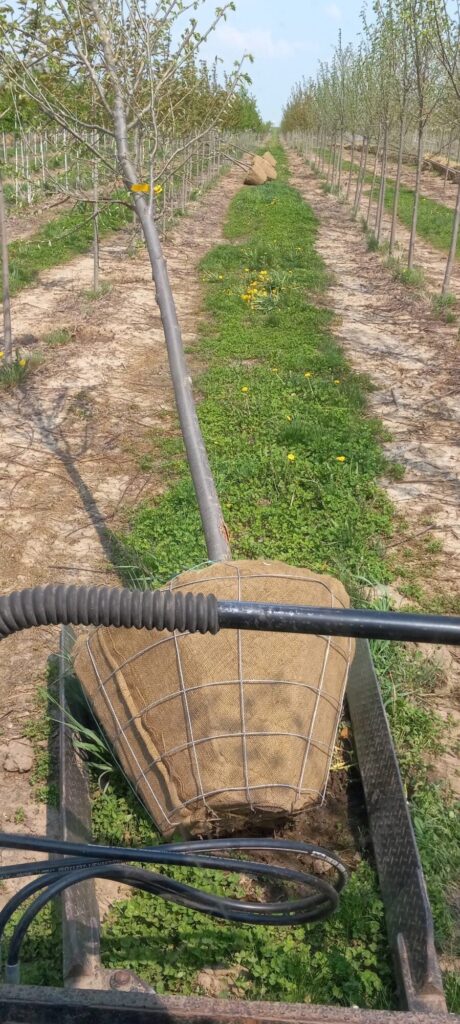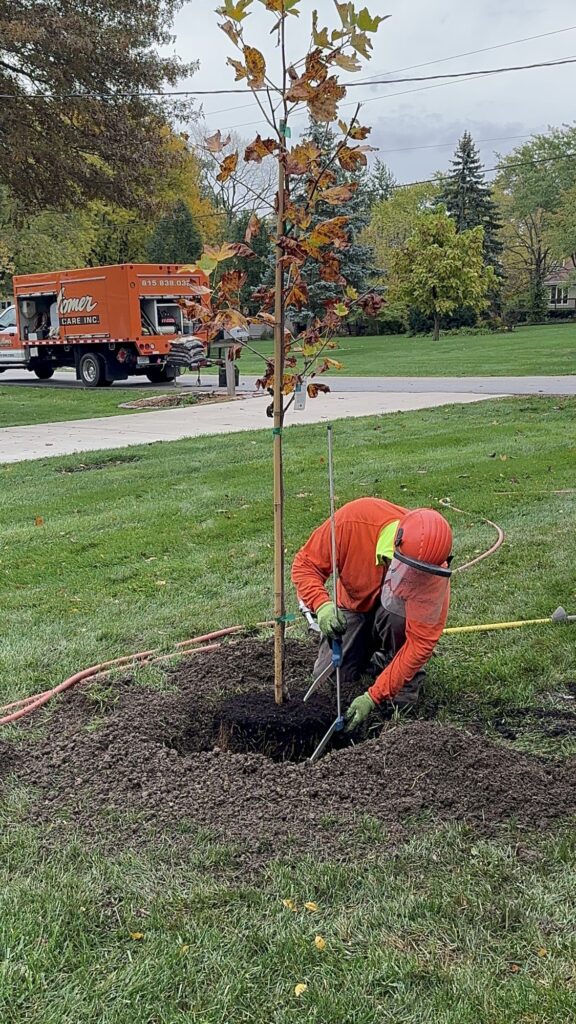Traditional methods for tree planting have been in practice for decades. Historically, tree planting has been done with ball and burlap-wrapped trees. A tree would be excavated from a nursery field with a section of the root zone intact with soil, then wrapped with burlap into a “root ball.” This ball and burlap tree would then be transported to the planting site, and buried into the landscape where it would establish into the new location. This method worked well for being very low-tech, cheap in materials, and relatively efficient. However, there were limitations.
Excavating the tree would typically be done with a tree spade. This tool is attached to a truck or heavy machine that uses giant metal blades to cut down into the soil and free the tree from the ground. The tree spade would also sever a majority of the underground roots, leaving them behind in the nursery field.

This loss of root mass at transplant means a lower survivability for the tree after planting. Diligent watering is necessary for survival, and some species of tree may be less forgiving of losing so many roots. Maple trees are particularly well suited for ball and burlap transplants with vigorously growing roots and very high survivability. Oaks on the other hand have a more difficult time dealing with root disturbance and have a lower survival rate with ball and burlap transplants. Ball and burlap root balls are also heavy and more difficult to work with, requiring heavy machines to excavate and move. Ball and burlap trees are also commonly transported in a metal basket which helps retain the shape of the root ball, but is commonly left during transplant and may cause root constriction as the tree matures.

With ball and burlap transplanting, correct planting procedures are critical. First, the top of the burlap should be cut away and the root flare should be exposed. This ensures that the newly planted tree is buried at the correct depth and will prevent future problems with trunk decay or root circling. A tree buried too deeply is much more prone to developing these problems as it matures. Then, as much of the wire basket surrounding the root ball should be removed as possible to reduce the risk of future root injury. The tree root ball should also be transplanted into a hole dug 2-3 times the width of the transplant root ball. Contractors commonly skip this step and will instead dig a hole with their tree spade, leaving the transplanted tree minimal room to establish new roots in fresh soil. This practice may extend the establishment period and limit new growth.

The loss of root mass at transplant also means that ball and burlap trees need time to establish and grow into the landscape. As a rule of thumb, the ball and burlap method requires a year per inch of trunk diameter just to recover from the initial root damage. This means a 2-inch tree transplanted into a new landscape will have dwarfed growth for 2 years following the planting. In the industry, we say, “First it sleeps, then it creeps, then it leaps!”
Ball and burlap is a good method for tree transplant, but it requires special care to be done properly and creates new risks to the long-term health of the tree. They can be avoided with proper care and planting procedures, but we find that many contractors in the industry tend to forgo those procedures instead of trying to maximize their efficiency and planting time and volume. What alternatives exist to ball and burlap transplanting, and how are they different? We’ll discuss our own method for planting in the next blog post. Should you have any inquiries about tree transplanting or need assistance with a tree that has been previously transplanted and may need saving, feel free to reach out to Homer Tree Care. Our experienced team is here to answer your questions and provide expert guidance for the well-being of your trees.

